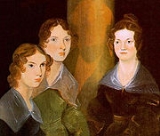
Brontë Way
Encyclopedia
The Brontë Way is a waymarked long-distance footpath in the northern counties of West Yorkshire
and Lancashire
, England
, United Kingdom
.
, near Dewsbury
, and finishes at Padiham
, Lancashire.
The route has been designed to have strong associations with the writings of the Brontë
family, incorporating places where their work was centred such as Top Withens
(inspiration for Wuthering Heights
), and Haworth
where the Haworth Parsonage where they lived is now a Brontë museum. It also encompasses interesting geographical and landscape highlights from the region such as Penistone Hill Country Park
and plenty of upland
and moorland
walking so that even if the novels have passed you by the route keeps your interest and is of value in its own right.
There is plenty to explore on and near the route from country pubs to industrial heritage and public transport links in to the route and its four main sections.
Two guidebooks are available.
West Yorkshire
West Yorkshire is a metropolitan county within the Yorkshire and the Humber region of England with a population of 2.2 million. West Yorkshire came into existence as a metropolitan county in 1974 after the passage of the Local Government Act 1972....
and Lancashire
Lancashire
Lancashire is a non-metropolitan county of historic origin in the North West of England. It takes its name from the city of Lancaster, and is sometimes known as the County of Lancaster. Although Lancaster is still considered to be the county town, Lancashire County Council is based in Preston...
, England
England
England is a country that is part of the United Kingdom. It shares land borders with Scotland to the north and Wales to the west; the Irish Sea is to the north west, the Celtic Sea to the south west, with the North Sea to the east and the English Channel to the south separating it from continental...
, United Kingdom
United Kingdom
The United Kingdom of Great Britain and Northern IrelandIn the United Kingdom and Dependencies, other languages have been officially recognised as legitimate autochthonous languages under the European Charter for Regional or Minority Languages...
.
Length
The Brontë Way runs for 69 km (43 mi). At a steady pace it may typically take four days to walk.The route
The Brontë Way starts at Birstall, West YorkshireBirstall, West Yorkshire
Birstall is a large village in the metropolitan borough of Kirklees, West Yorkshire, England and situated roughly 6 miles south-west of Leeds. It features a quaint triangular Victorian marketplace, which replaced an earlier market on High Street in the Georgian area of the village further up the hill...
, near Dewsbury
Dewsbury
Dewsbury is a minster town in the Metropolitan Borough of Kirklees, in West Yorkshire, England. It is to the west of Wakefield, east of Huddersfield and south of Leeds...
, and finishes at Padiham
Padiham
Padiham is a small town and civil parish on the River Calder, about west of Burnley and south of Pendle Hill, in Lancashire, England. It is part of the Borough of Burnley but also has its own town council with varied powers.-History:...
, Lancashire.
The route has been designed to have strong associations with the writings of the Brontë
Brontë
The Brontës were a nineteenth-century literary family associated with Haworth in the West Riding of Yorkshire, England. The sisters, Charlotte , Emily , and Anne , are well-known as poets and novelists...
family, incorporating places where their work was centred such as Top Withens
Top Withens
Top Withens is a ruined farmhouse near Haworth, West Yorkshire, England which is said to have been the inspiration for the location of the Earnshaw family house Wuthering Heights in the novel of the same name by Emily Brontë....
(inspiration for Wuthering Heights
Wuthering Heights
Wuthering Heights is a novel by Emily Brontë published in 1847. It was her only novel and written between December 1845 and July 1846. It remained unpublished until July 1847 and was not printed until December after the success of her sister Charlotte Brontë's novel Jane Eyre...
), and Haworth
Haworth
Haworth is a rural village in the City of Bradford metropolitan borough of West Yorkshire, England. It is located amongst the Pennines, southwest of Keighley and west of Bradford. The surrounding areas include Oakworth and Oxenhope...
where the Haworth Parsonage where they lived is now a Brontë museum. It also encompasses interesting geographical and landscape highlights from the region such as Penistone Hill Country Park
Country park
A country park is an area designated for people to visit and enjoy recreation in a countryside environment.-History:In the United Kingdom the term 'Country Park' has a special meaning. There are over 400 Country Parks in England alone . Most Country Parks were designated in the 1970s, under the...
and plenty of upland
Highland (geography)
The term highland or upland is used to denote any mountainous region or elevated mountainous plateau. Generally speaking, the term upland tends to be used for ranges of hills, typically up to 500-600m, and highland for ranges of low mountains.The Scottish Highlands refers to the mountainous...
and moorland
Moorland
Moorland or moor is a type of habitat, in the temperate grasslands, savannas, and shrublands biome, found in upland areas, characterised by low-growing vegetation on acidic soils and heavy fog...
walking so that even if the novels have passed you by the route keeps your interest and is of value in its own right.
There is plenty to explore on and near the route from country pubs to industrial heritage and public transport links in to the route and its four main sections.
Two guidebooks are available.

